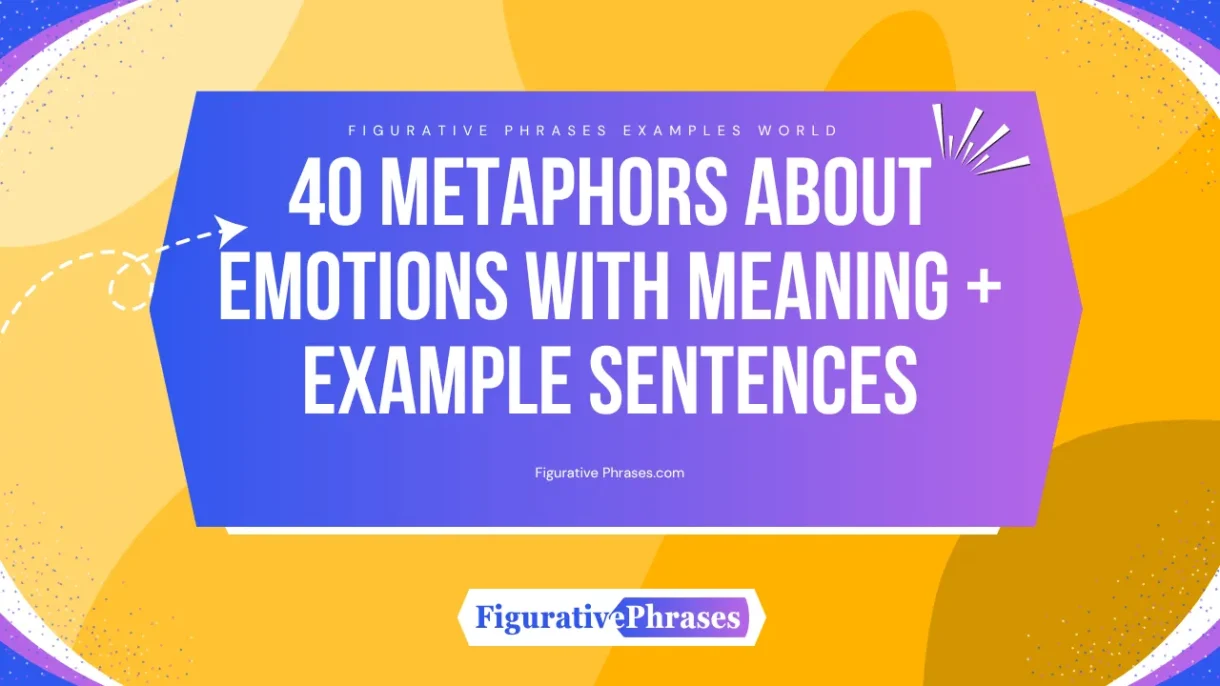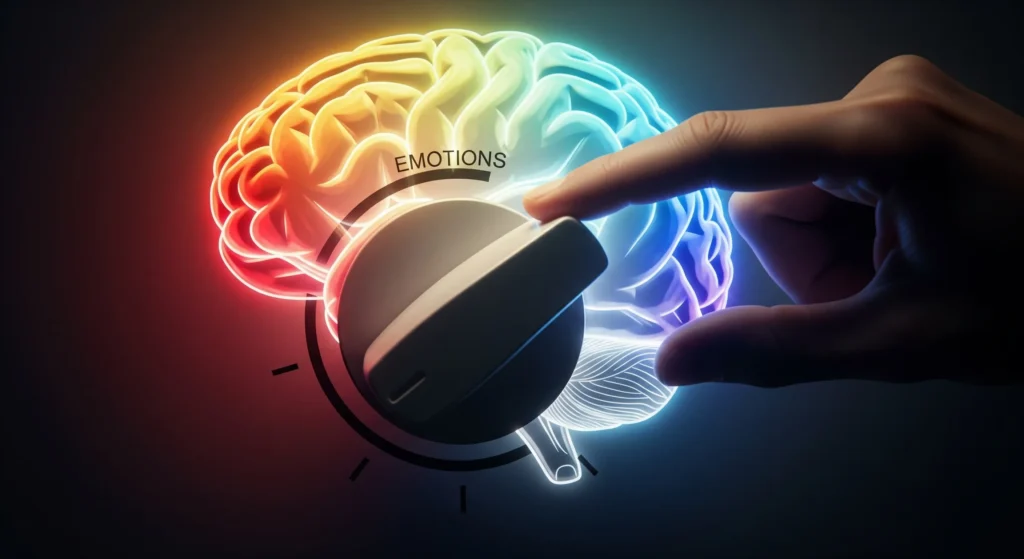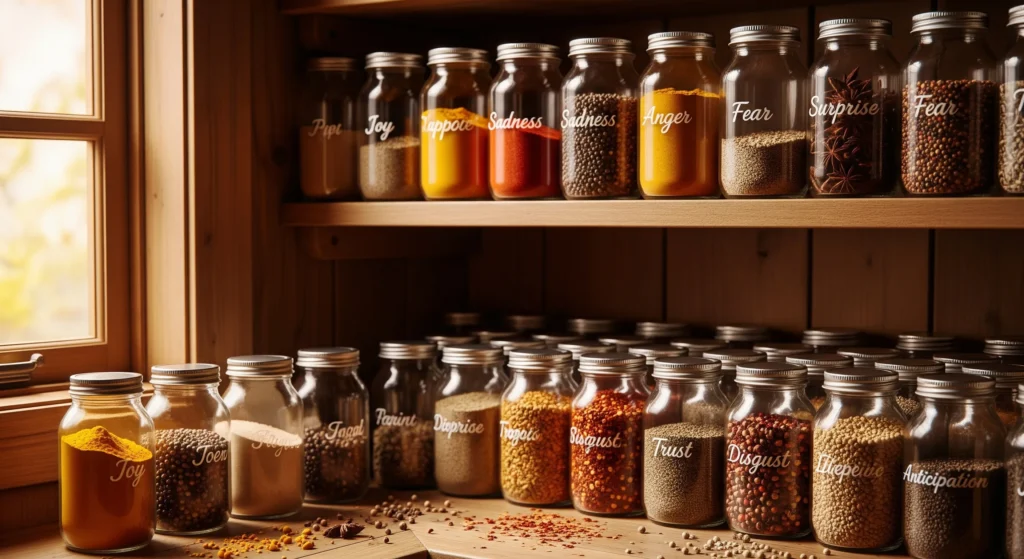
I wrote this guide to help you talk about feelings with clear, simple pictures. Inside, I share 40 fresh metaphors for emotions—happiness, sadness, love, hate, anger, calm, excitement, boredom, and mixed feelings. For each one, I give the meaning, when to use it, a short example sentence, and quick “other ways to say” terms. I also add a small link from one feeling to the next so the ideas flow. Use these lines to write posts, explain your mood, or make your stories easier to feel.
What are the Metaphors about emotions with examples?
Emotions are internal signals that steer choices, shape attention, and prime action. Think of them as systems—tools you can read, not storms you must obey.
Emotions are a weather system
Meaning: Feelings change in fronts and seasons.
When to use: To explain shifting moods over time.
Example: “By noon my mind cleared; yesterday’s squall had passed.”
Other ways to say: climate, barometer, forecast, pressure front
Emotions are a dashboard
Meaning: Feelings warn, confirm, or ask for maintenance.
When to use: To frame emotions as data, not destiny.
Example: “That flicker of dread was a red light, so I slowed down.”
Other ways to say: indicator, gauge, warning light, readout
Emotions are a river current
Meaning: They carry you unless you steer.
When to use: To show regulation and choice.
Example: “I angled my thoughts to slip out of the riptide.”
Other ways to say: flow, undertow, drift, channel
Emotions are a compass
Meaning: They point at needs and values.
When to use: To decide what matters most.
Example: “My irritation pointed north to a boundary I hadn’t set.”
Other ways to say: true north, bearing, needle, heading
Emotions are a dimmer switch
Meaning: They can be raised, lowered, or blended.
When to use: To discuss intensity control and nuance.
Example: “I eased the dial from gray to gold before the meeting.”
Other ways to say: slider, dial, gradient, modulation

(moves us toward happiness as the light turns brighter)
What are the Metaphors about Happiness With Examples?
Happiness is warm energy that expands attention and invites connection. Happy metaphors like it widens the room inside your chest.
Happiness is sunlight in the chest
Meaning: Warmth that spreads and brightens thought.
When to use: To show gentle, steady joy.
Example: “Her message put sunlight in my chest all morning.”
Other ways to say: glow, warmth, golden hour, daylight
Happiness is a lifted window
Meaning: Openness that lets life in.
When to use: To show fresh perspective.
Example: “After the deadline, it felt like someone raised the sash.”
Other ways to say: breeze, open frame, clear view, fresh air
Happiness is a spring on the step
Meaning: Buoyancy that makes effort lighter.
When to use: To show energized action.
Example: “With the grant approved, my feet found a spring.”
Other ways to say: bounce, lift, buoy, pep
Happiness is a tune that hums back
Meaning: Joy that echoes and sustains itself.
When to use: To show lingering good mood.
Example: “The good news kept humming through the afternoon.”
Other ways to say: refrain, chorus, ripple, afterglow
Happiness is a lantern you pass around
Meaning: Shared joy grows brighter in company.
When to use: To invite celebration.
Example: “We passed the lantern, lighting each face in turn.”
Other ways to say: shared spark, communal light, circle glow
(sets up sadness when the light dims)
What are the Metaphors about Sadness With Examples?
Sadness is a weight that asks you to slow down and look at what mattered. sad metaphors like It is a rain that waters memory.
Sadness is rain on the room
Meaning: A soft, persistent hush that changes tone.
When to use: Quiet, reflective sorrow.
Example: “After the goodbye, the room spoke in rain.”
Other ways to say: drizzle, downpour, gray veil, wet hush
Sadness is a stone in the pocket
Meaning: A steady weight carried everywhere.
When to use: Ongoing grief or loss.
Example: “I worked fine, but the stone stayed with me.”
Other ways to say: burden, ballast, pebble, weight
Sadness is a hollow chair
Meaning: The shape of someone missing.
When to use: Bereavement or absence.
Example: “At dinner, the hollow chair said their name.”
Other ways to say: empty seat, quiet place, missing space
Sadness is fog on the path
Meaning: Low visibility; hard to plan ahead.
When to use: Unclear next steps.
Example: “I walked slow; the fog made every plan guesswork.”
Other ways to say: mist, low cloud, whiteout, blur
Sadness is cloth that needs mending
Meaning: Time and care can repair tears.
When to use: Healing arcs and resilience.
Example: “I threaded patience and stitched from edge to edge.”
Other ways to say: seam, patch, weave, fabric
(opens to love—the hands that mend belong to care)
What are the Metaphors about Love With Examples?
Love is an anchoring gravity and a green room for growth. It orients, shelters, and stretches you.
Love is a home key
Meaning: A place-note your life resolves to.
When to use: Long-term steadiness.
Example: “After the noise, you were the note that settled me.”
Other ways to say: root, tonic, ground, base
Love is a greenhouse
Meaning: Protection that helps each person bloom.
When to use: Supportive partnerships.
Example: “Under your care, my shy ideas came to leaf.”
Other ways to say: shelter, warm frame, glasshouse, nurture bed
Love is a braided rope
Meaning: Strength from intertwined lives.
When to use: Teamwork and trust.
Example: “We climbed because our rope held steady.”
Other ways to say: cord, strand, weave, bind
Love is a well you draw from
Meaning: Reliable source of renewal.
When to use: Mutual support.
Example: “On thin days, I lower the bucket and rise full.”
Other ways to say: spring, reservoir, cistern, source
Love is a coin with a sharp edge
Meaning: Deep care can cut when turned.
When to use: To foreshadow conflict or betrayal.
Example: “The same coin that gleamed nicked my thumb.”
Other ways to say: double edge, bright blade, keen rim
(turns us toward hate—the wounded edge of care)
What are the Metaphors about Hate With Examples?
Hate is corrosive heat that narrows vision and burns bridges. It spends energy to leave ash.
Hate is acid in the hand
Meaning: It harms the holder first.
When to use: Self-damage of resentment.
Example: “I kept the acid and wondered why I ached.”
Other ways to say: corrosive, caustic, etch, burn
Hate is a tunnel with no exits
Meaning: Obsession that blocks options.
When to use: Fixation on an enemy.
Example: “Inside that tunnel, every step looked the same.”
Other ways to say: dead end, choke point, cul-de-sac, trap
Hate is a salt field
Meaning: It makes future growth harder.
When to use: Long-term consequences.
Example: “We salted the field and starved tomorrow.”
Other ways to say: scorched earth, barren bed, blight, spoil
Hate is a mirror cracked on purpose
Meaning: It distorts the other to justify harm.
When to use: Dehumanization.
Example: “Through that mirror, their face always looked wrong.”
Other ways to say: warped glass, funhouse, smear, distortion
Hate is a match near dry straw
Meaning: Quick to ignite into anger.
When to use: Escalation moments.
Example: “One word, and the straw leapt to flame.”
Other ways to say: tinder, spark, flare, flash
(ignites the next section: anger)
What are the Metaphors about Anger With Examples?
Anger is pressurized heat that demands movement or release. Handled well, it powers change; mishandled, it scorches.
Anger is steam in a sealed valve
Meaning: Pressure builds until it finds a vent.
When to use: Signs you need to pause or speak.
Example: “I felt the valve rattle and chose to open it.”
Other ways to say: pressure, vent, gauge, release
Anger is a flare gun
Meaning: A bright signal that something’s wrong.
When to use: Boundary violations.
Example: “The flare lit the sky over my limit line.”
Other ways to say: signal fire, beacon, distress shot, alert
Anger is a blacksmith’s forge
Meaning: Heat that can shape stronger tools.
When to use: Turning outrage into action.
Example: “We took the heat and hammered policy into form.”
Other ways to say: anvil, temper, quench, hammer
Anger is a storm on short cables
Meaning: Explosive bursts that pass fast.
When to use: Quick temper episodes.
Example: “The storm snapped and was gone in minutes.”
Other ways to say: squall, crack, burst, snap
Anger is an ember in water
Meaning: Cooling is possible with care.
When to use: De-escalation and calm.
Example: “I breathed until the ember sighed under the surface.”
Other ways to say: douse, cool, settle, soothe
(glides into calm)
What are the Metaphors about Calm With Examples?
Calm is low wind and wide sight. It is steadying ballast that lets choices land well.
Calm is a wide lake at dawn
Meaning: Stillness that reflects things clearly.
When to use: Clear thinking moments.
Example: “With the emails done, the lake went flat and bright.”
Other ways to say: glass water, mirror surface, morning still
Calm is sand in the keel
Meaning: Weight that keeps the boat upright.
When to use: Grounding practices.
Example: “A slow walk put sand back in my keel.”
Other ways to say: ballast, center, anchor, weight
Calm is unknotted rope
Meaning: Tension released and usable again.
When to use: Recovery after stress.
Example: “After stretching, my thoughts lay like loose rope.”
Other ways to say: slack, ease, loosen, unbind
Calm is a librarian’s finger to the lips
Meaning: A cue that quiet helps.
When to use: Group de-stress cues.
Example: “One gentle hush settled the team.”
Other ways to say: hush, quiet sign, still cue, silence mark
Calm is a runway light
Meaning: It guides safe motion and landing.
When to use: Entering exciting events smoothly.
Example: “I set the runway lights before the product launch.”
Other ways to say: approach line, guide path, beacon
(points to excited states next)
What are the Metaphors about Excited With Examples?
Excitement is fast current and bright voltage. It accelerates focus and primes action.
Excitement is a drumline in the ribs
Meaning: Rhythms pump you forward.
When to use: Anticipation before events.
Example: “The drumline started when my name was called.”
Other ways to say: cadence, beat, thrum, pulse
Excitement is carbonated blood
Meaning: Fizzy energy in the body.
When to use: Bursts of joy or nerves.
Example: “The idea bubbled through me like soda.”
Other ways to say: fizz, sparkle, pop, bubbles
Excitement is green lights in a row
Meaning: Momentum with no stops.
When to use: A streak of wins.
Example: “Every call hit green, so we pushed harder.”
Other ways to say: go-signal, clear run, open lane, flow
Excitement is a kite in steady wind
Meaning: Lift that you can steer.
When to use: Productive hype with control.
Example: “We trimmed the string and climbed higher.”
Other ways to say: lift, pull, glide, soar
Excitement is a sparkler that burns fast
Meaning: Fun but brief; needs pacing.
When to use: To warn about burnout.
Example: “I loved the sparkle, then I set the stick down.”
Other ways to say: flash, flare, burst, quick burn
(leads to boredom after the spark fades)
What are the Metaphors about Boredom With Examples?
Boredom is low signal and slow time. It asks for novelty, challenge, or meaning.
Boredom is a room with blank walls
Meaning: No cues to engage attention.
When to use: Repetitive tasks.
Example: “By hour three, the walls went featureless.”
Other ways to say: blank space, empty frame, plain box
Boredom is sand in the gears
Meaning: Friction without progress.
When to use: Tedious workflows.
Example: “The process ground on with sandy teeth.”
Other ways to say: grit, drag, grind, slowdown
Boredom is gray static
Meaning: A low, dull noise that fills space.
When to use: Mindless scrolling, idle waiting.
Example: “The feed became static, so I put it away.”
Other ways to say: hum, fuzz, white noise, drone
Boredom is an unplayed instrument
Meaning: Capacity without use.
When to use: Skills underused at work.
Example: “My violin gathered dust while I filed forms.”
Other ways to say: idle tool, quiet talent, shelved skill
Boredom is a door that wants a knock
Meaning: It invites you to create a prompt.
When to use: To cue a new idea or task.
Example: “I knocked with a question, and the door opened.”
Other ways to say: cue, prompt, trigger, opener
(opens to ‘other emotion metaphors’—fresh prompts)
What are other Metaphors about emotions With Examples?
Emotions are multi-tool processes: they label, energize, and guide. These metaphors cover regulation and expression.
Emotions are a pantry of spices
Meaning: You can blend intensity and flavor.
When to use: Choosing tone in communication.
Example: “I used honesty, but I tempered it with thyme.”

Other ways to say: mix, blend, dash, seasoning
Emotions are software updates
Meaning: Alerts you to install new patterns.
When to use: Habit change moments.
Example: “Frustration pinged me to patch my morning routine.”
Other ways to say: patch, version, upgrade, release
Emotions are traffic laws
Meaning: Signals that make groups safe.
When to use: Team norms and empathy.
Example: “Our impatience ran a red, so we reset.”
Other ways to say: right-of-way, yield, stop, merge
Emotions are currency
Meaning: You can invest, spend, or save energy.
When to use: Managing social effort.
Example: “I saved joy coins for the hard talk.”
Other ways to say: budget, deposit, withdraw, interest
Emotions are instruments in an orchestra
Meaning: Balance makes harmony; excess draws noise.
When to use: Emotional literacy and blending.
Example: “I lowered anger’s brass and let empathy’s strings lead.”
Other ways to say: section, score, conductor, tempo
(sets up mixed emotions—polyphony by design)
What are The Metaphors about Mixed emotions With Examples?
Mixed emotions are chords, not single notes. Two truths can sound at once without canceling each other.
Mixed emotions are a braid of colors
Meaning: Feelings intertwine without merging.
When to use: Bittersweet events.
Example: “Graduation braided pride with parting blue.”
Other ways to say: strand, twist, thread, weave
Mixed emotions are a chord on one piano
Meaning: Notes stack to make richer sound.
When to use: Joy and fear together.
Example: “New parenthood rang C-major with a minor edge.”
Other ways to say: harmony, voicing, triad, interval
Mixed emotions are two tides meeting
Meaning: Currents collide and pattern the surface.
When to use: Conflicting pulls.
Example: “I felt drawn home and pulled outward at once.”
Other ways to say: confluence, crosscurrent, meeting seam, eddy
Mixed emotions are a sunrise in rain
Meaning: Light and drizzle share the sky.
When to use: Hope during grief.
Example: “We cried, yet gold kept breaking through.”
Other ways to say: sunshower, split sky, bright rain, double scene
Mixed emotions are a menu with two good choices
Meaning: Ambivalence between appealing paths.
When to use: Hard decisions with upsides both ways.
Example: “I held two yeses and had to pick one.”
Other ways to say: fork, option set, twin wins, either-way good






0 Comments